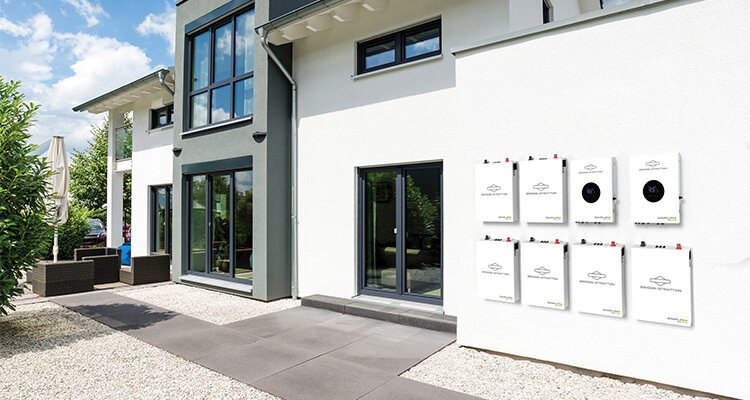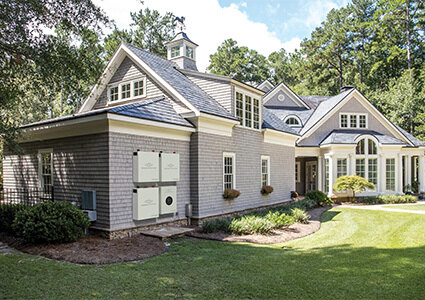
Sequoya Cross explores the growing demand for backup power and why homebuilders should be paying attention to these developing technologies
In an era of escalating extreme weather and deteriorating grid infrastructure, homeowners find themselves facing increasingly frequent power outages. These disruptions, which range from minor inconveniences to critical crises, have forced homeowners to reevaluate their dependence on traditional energy sources. Federal data found that in 2020, more than 180 large, sustained outages occurred, while in 2000, there were fewer than two dozen major power outages.
Distributed, customer-sited backup power solutions are becoming more common and more critical for people to protect their homes and businesses from

blackouts and economic losses. While home standby generators have historically been the most well-known backup solution, energy storage systems (ESS) are an additional option that creates energy reserves. Some consumers looking for ultimate energy independence are opting to install both a standby generator and an ESS to reduce the run-time and fuel costs of the generator.
As homeowners look for energy resiliency and security in the face of more numerous power outages, severe weather, aging utility infrastructure and rising energy bills, homebuilders can have an edge over the competition by adapting to their customers’ changing needs and providing the necessary infrastructure to integrate new technologies into homes.
Home standby generators
One of the most dependable and robust solutions is the integration of home standby generators. A well-designed generator will switch the power over automatically without any action from the homeowner, making it a quick and seamless experience. Home standby generators typically run on natural gas or propane, offering a reliable source of power for an extended period.
Homeowners are increasingly considering home standby generators as a way to secure their energy supply during outages. These generators can power essential appliances, heating and cooling systems and even the entire home, depending on their size and capacity. Additionally, modern home standby generators are quieter, more efficient and more affordable.
Home standby generators offer homeowners a host of advantages beyond security and comfort during an outage, including protection against storm damage and power outage costs. They also lower homeowners insurance bills. A recent study by Remodeling magazine showed that standby generators increase home resale values by 52.7 percent of the cost of the generator system. They are long-term investments that often boost home values, making them an attractive feature for homebuilders to incorporate into new construction.
Energy storage systems
In the age of renewable energy, ESS is gaining popularity as a backup power solution. ESS can store power from any generation source, such as solar panels, a generator or the utility grid itself. That power can be used immediately to run electrical loads in a home or it can be stored in the batteries for a later use.
These systems can use lithium-ion, lead acid or other battery technologies, but those considered by experts to be the safest on the market run on a subset of lithium-ion battery power called lithium Iion phosphate (LiFePO4) chemistry. LiFePO4 eliminates cobalt, which, in turn, reduces the risk of thermal runaway, fire propagation, operating temperature constraints and toxic coolants to deliver more efficient, safer and reliable energy storage.
 An ESS offers a modular and scalable solution for homeowners to customize its backup power solutions based on energy needs. Furthermore, integrating energy storage systems with home energy management systems and grid connectivity can create smart, responsive homes. These systems enable homeowners to make informed decisions about their own generation and consumption to maximize their energy security and utility rate cost savings. Seven in ten homebuyers are actively looking for a smart home, and 59 percent of Americans who are concerned with climate change are willing to pay more for smart home devices.
An ESS offers a modular and scalable solution for homeowners to customize its backup power solutions based on energy needs. Furthermore, integrating energy storage systems with home energy management systems and grid connectivity can create smart, responsive homes. These systems enable homeowners to make informed decisions about their own generation and consumption to maximize their energy security and utility rate cost savings. Seven in ten homebuyers are actively looking for a smart home, and 59 percent of Americans who are concerned with climate change are willing to pay more for smart home devices.
As ESS technology becomes more affordable, and state and federal governments incentivize the adoption of renewable technologies. An opportunity is created for homebuilders to embrace and incorporate energy storage solutions into new homes, giving homeowners the option to utilize renewable energy and ensure their energy security in the face of outages.
Opportunities for homebuilders
The landscape of backup power solutions is evolving rapidly as these technologies continue to develop and become more affordable. Homeowners are increasingly looking for ways to take control of their energy dependence, and advanced technologies like home standby generators and energy storage systems offer a promising path forward.
Homebuilders have a pivotal role to play in this transition. Incorporating advanced backup power solutions into new homes not only meets the growing demands of homeowners but also positions homebuilders as leaders in the evolution of sustainable and resilient housing.
Sequoya Cross
www.briggsandstratton.com/na/en_us/home.html
Sequoya Cross is the Vice President of Energy Storage at Briggs & Stratton Energy Solutions, where she oversees the full go-to-market process, driving process definition, continuous improvement and accountability for execution across direct and indirect functional support areas such as sales and product development. She also juggles supporting and growing the renewables distributor network and manages a portfolio of large-scale storage-based projects with development partners.